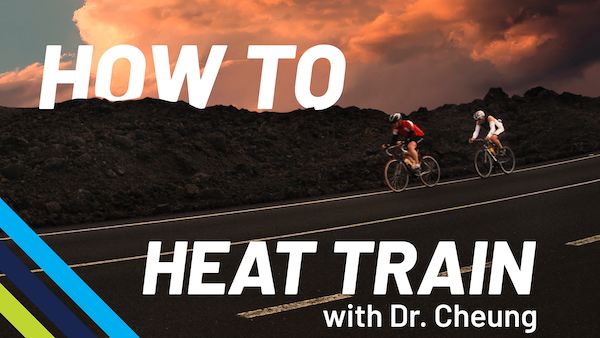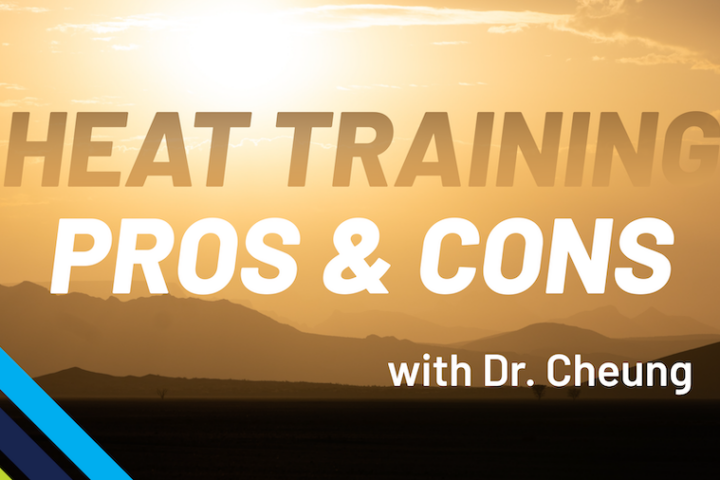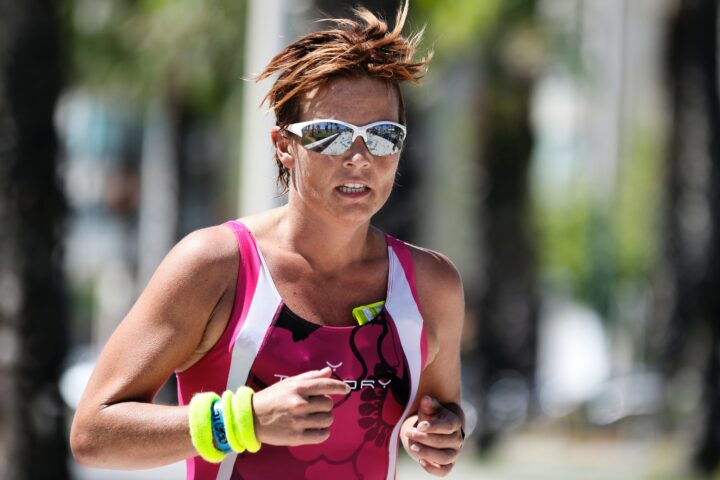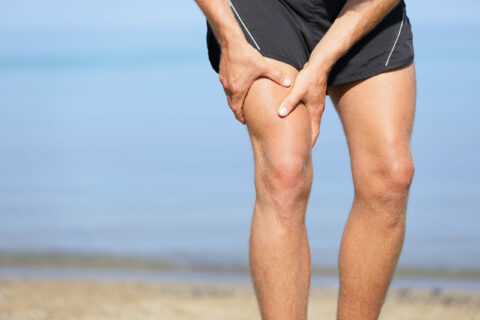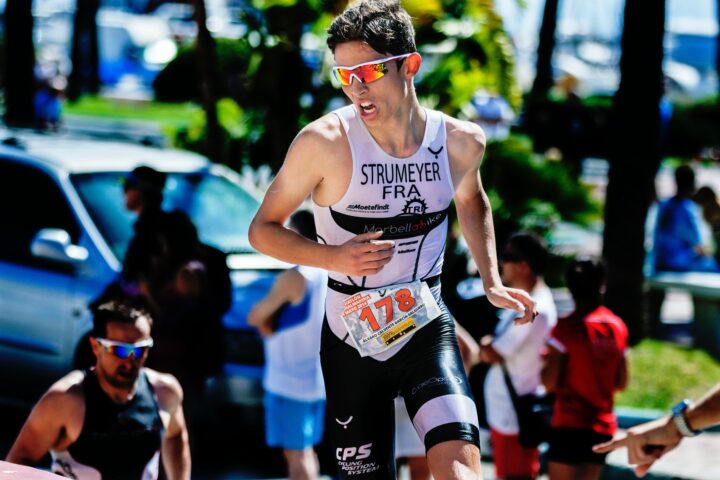Dr. Stephen Cheung explores how to develop heat adaptation protocols that fit your event, budget, and circumstances.
Video Transcript
Intro 00:09
Welcome to Fast Talk Laboratories, your source for the science of endurance performance.
Introduction to Heat Adaptation
Dr. Stephen Cheung 00:19
Welcome to Fast Talk Labs. I’m Dr. Stephen Cheung, a professor, and Senior Research Fellow in the Department of Kinesiology at Brock University in Canada. For many of us, our prime events happen during summertime when the weather can become very hot. Exercising in the heat, or when your body is hotter than normal, can have a negative effect on our exercise capacity. There are lots of things that you can do to mitigate that impairment, but the best thing you can do systemically is to adapt yourself to hot temperatures well before the competition itself. In today’s workshop, we’ll take a macro look at the major practical logistics and considerations in developing a heat adaptation protocol.
Heat Stress and Higher Body Temperatures Are Not Always a Negative
Dr. Stephen Cheung 01:06
One important first question to get out of the way is whether heat stress and higher body temperatures is always a negative. The answer to that is no, heat is not always bad, and indeed can sometimes be a strong ergogenic aid. The classic study by Balanol in 1999 demonstrated that peak and mean power outputs during a 30-second wind gate sprint test was actually higher when done in 30 degrees Celsius, than when done in 19 degrees Celsius. Warming muscles up also leads to higher maximal contractile force capacity of that individual muscle. This graph is taken from data over the course of the World Athletics Championships over 20 years, with the top graph being female and the bottom graph being male data. You can see that at around 800-meter running, or roughly two minutes a max effort seems to be the tipping point where heat becomes a negative factor. So, if you’re a track sprinter or a kilo rider, or a BMX, or downhiller, physiologically, adapting to the heat prior to competition is likely unnecessary. However, while we won’t get into it in this specific workshop, being pre-exposed to hot conditions can still improve your thermal perception and your mental response to heat stress for these short-duration athletes.
Dr. Stephen Cheung 02:36
It’s important to realize that when we use the phrase heat adaptation, we’re talking about a lot of different physiological systems and not just one big black box. Each of these physiological systems or parameters have their own timelines for responses, with some such as heart rate and core temperature being relatively fast responders, while others, such as sweating rate have a much longer time course. We see in this general schematic that resting and exercise heart rate, shown in the red line at the bottom adapts quite quickly, with most of the changes happening within the first week, and not much in a way of further changes beyond that. In contrast, we see that increases in sweating rate and changes in electrolyte concentration in the sweat, shown in the brown line can take two weeks or more to fully adapt and stabilize. So, as a rule of thumb, you can get away with a short-term adaptation program of as little as four to five days, and you’ll still get a good majority of the benefits. But generally, the longer you can plan the heat adaptation program, the better and probably the more stable those changes will remain afterwards.
Individual Characteristics Can Affect Response to a Heat Adaptation Program
Dr. Stephen Cheung 03:52
The other important thing to remember is that our individual characteristics can affect the rate and magnitude of response to a heat adaptation program. The vast majority of heat adaptation research has been done in males with our meta-analysis in 2016, finding that only about 7% of nearly 1000 participants across multiple studies were female. Therefore, it may not be appropriate to directly apply heat protocols based on male data to female athletes. For example, in 2015, Jessica Mee in the UK directly tested both male and female participants over a 10-day heat adaptation program, with testing also done halfway after four to five days. She found that the short-term heat adaptation of four to five days was sufficient for improvements in heart rate, core temperature, and also in performance with the male participants. In that, no further significant improvement were seen in these males after 12-to-14-days. However, with the female participants, there were no significant improvements in heart rate, core temperature, or performance after the first four to five days. However, after 12-to-14-days, we did see a similar improvement overall in the males and females. This suggests that females can still attain the same level of heat adaptation as males, but it actually takes longer to achieve.
Fitness and Heat Adaptation
Dr. Stephen Cheung 05:25
We also know that being fit generally decreases your resting heart rate, and your resting core temperature compared to a sedentary individual. Therefore, there is a notion that being fit already gets you partly heat adapted, and that it can also increase the rate of adaptation when you do take on a specific heat adaptation protocol. In our meta-analysis in 2016, we did not find any faster rate of adaptation in fit compared to less fit individuals, that we did find that even highly fit individuals can still improve their heat responses following heat adaptation.
Ways to Preform Heat Adaptation
Dr. Stephen Cheung 06:06
So, what are some ways by which we can perform heat adaptation? The most obvious would be to exercise in a hot environment. But overall, the main priority seems to be really raising your body temperature higher than normal and keeping it there for roughly 60 to 90 minutes a day, for roughly seven to 14 days. So, for those without access to a heat chamber, like I have in my lab, one popular method is through passive heat exposure in either a sauna or in a hot tub. If you are doing this, the ideal time is to do it immediately after a training belt when your body temperature is already high. So, what you’re really doing is just keeping your body temperature high with that hot tub or sauna, rather than trying to raise it right from resting. If doing passive heat exposure right after exercise, I would suggest having your recovery nutrition ready and waiting so that you are not delaying that part of recovery. The reason that I recommend passive heat exposure after exercise rather than before, is that it takes a lot more time and is much more draining to raise your temperature with a sauna or hot tub, compared to the massive amounts of heat that you are generating naturally when you actually exercise.
Performing Heat Adaptation Without Equipment
Dr. Stephen Cheung 07:29
So, then what happens if you have access to neither a heat chamber or a hot tub or a sauna? Well, the very simple poor person solution is a simple layer on a lot more clothing while you were riding. This seems simple, but is it actually effective? The answer seems to be partly. In 2018, Ely Atol tested this question on runners by comparing the responses to running with minimal clothing in a hot environment of 40 degrees Celsius, and 30% relative humidity, comparing this to a clothing condition, where the participants ran in a temperate environment of 15 degrees Celsius, and 50% relative humidity, but piled on Winter clothing. We see on the graph that the hot conditions raised core temperatures significantly higher than the temperate and clothing condition, but that the temperate and clothing condition still raised core temperature to 38.5 degrees Celsius by the end of the 50-minute run, and a rise in core temperature of about one and a half degrees Celsius in the clothing condition, which seems to be about the minimum threshold that you need for some form of heat adaptation. Unfortunately, the study had no true control condition involving the wearing of minimal clothing while running in 15 degrees Celsius, but it does suggest that clothing can get you part of the way to becoming heat adapted.
Adding Dehydration to Heat Training
Dr. Stephen Cheung 09:02
Another twist to heat adaptation as some have explored is whether combining a slight amount of dehydration during the heat training itself can accelerate the overall rate of heat adaptation. In this 2014 study by Andrew Garrett during his time in New Zealand, he looked at the impact of a short-term, five-day heat adaptation program either with or without dehydration during the heat training. The dehydration itself was not major and kept within the general guidelines of not losing more than 2% body mass. Following the five-day heat adaptation program, both core temperature and heart rate responses were slightly improved in the dehydration condition compared to heat adaptation done while maintaining full hydration status. This suggests that there’s some form of synergy between dehydration and heat stress that may accelerate heat adaptation. If you’re going to try this, one important thing to keep in mind is to monitor your hydration status and body weight carefully, so that you’re recovered and back to a hydrated level overnight or before the next training session. It should also be noted that there is relatively very little research on this topic, and other studies have not always been able to replicate the same improvement with dehydration during heat adaptation.
Does Heat Adaptation Transfer Across Environments?
Dr. Stephen Cheung 10:25
Another important question is whether heat adaptation transfers across environments. That is, if you’re going to compete in a warm and humid environment, like in the tropics, is it okay to heat adapt to a hot dry environment? In general, I would say that it is okay if the primary stimulus you’re after is really the raise and keep your body temperature high. In the only study directly test this, Griefahn had a control condition with a wet bulb globe temperature of 21 degrees Celsius, then three hot conditions were the WBGT was similar at 33.5 degrees Celsius. However, the nature of that heat was different, there was a warm and humid condition, a hot and dry conditions like you might see in the desert, and then a heat condition from high solar radiation load. What she found was that the three heat adaptation conditions all induce similar benefits after two weeks, but then the unique twist she added was crossing over conditions after two weeks, such that the warm and humid group and also the solar group were also tested in a hot and dry environment, while the hot and dry group was tested in the warm and humid environment. Responses to those heat stress test in the different environments were similar to those in each group’s original environments, suggesting that heat adaptation can indeed transfer across environments. There is a caveat in that this is the only study I know of testing this, but it does fit with a general model whereby the main goal of heat adaptation is to provide thermal stimulus to the body, and that the body doesn’t really care how it is actually done.
How Long Does Heat Adaptation Last?
Dr. Stephen Cheung 12:14
So congrats, your heat adapted. Now what? One obvious question is how long this might actually last. Daanen, in 2018 did a meta-analysis on a relatively few studies looking at the rate of heat acclamation decay, and also how quickly heat acclamation can be reinduced after decaying. The good news is that heat adaptation physiological responses, like heart rate and core temperature changes seem to last quite a while. With Daanen modeling decay at about two and a half percent per day, it does seem that the longer the original heat adaptation protocol, the more stable and slow the rate of decay. So, even if you’ve partially decayed your heat adaptation, it seems that it can be restored quite quickly. This can be done with either another short block of dedicated heat training or a better approach might be just to have one to two bouts of heat training weekly to maintain heat adaptation long-term. Another caveat is that most of these the case studies have focused on physiology and not on actual performance itself.
Heat Adaptation Protocol and Competition Plans
Dr. Stephen Cheung 13:28
So, you figured out a heat adaptation protocol, but how do you fit it into your overall competition plan? There are a few approaches, and I’ve ranked them in order of my recommendation. The first is to start well before your main competition, so six to eight weeks out. Then once you’re adapted, maintain it with one to two heat bouts weekly, generally during your longer endurance days. This way, there’s less juggling around your main peaking and tapering. For me, the least preferred method or approach is to mix and match right before travel and competition, as your now combining the three big stressors of heat adaptation, travel and tapering. Option two and three are pretty viable and really depend on your travel schedule. To finish off as a practical example, let’s look at how I advise to Amber Neben and her coach Tim Cusick before the 2016 worlds in Qatar, in terms of preparing for the heat. Amber is based in Southern California, where in October, it’s comfortable, but not nearly the high heat she would be facing Qatar. She actually had access to a home sauna, which also helped with our planning.
Amber Neben’s Heat Adaptation Plan
Dr. Stephen Cheung 14:41
What did our plan end up looking like? We were very holistic in terms of adapting it to her training plan, and also her situation. If you recall the different approaches from two slides back, we went with my preferred approach and started about six to eight weeks before race day. Knowing that we didn’t necessarily have an ideal setup of a heat chamber, but that we had the benefit of time, we incorporated heat training four to five times a week, over three weeks to ensure maximal heat adaptation. Most of the heat sessions were done during endurance efforts, as we decided that we wanted Amber to perform her key intervals optimally. That is, we wanted her to get full neuromuscular metabolic benefits of hitting, for example, 350-watts for a set interval, rather than only 300-watts, because she was also heat stressed. For added heat stress during her rides, we had Amber pile on extra clothing. This was especially useful in days where we had her do intervals early in her ride, and then we piled on clothing for the back half of the ride to maintain a high temperature. We also had her jump from the bike straight into the sauna. Once we achieved heat adaptation, we then maintained it before traveling competition with one to two sauna sessions after training, per week. And finally, we did set up a couple of full simulations where we had Amber do race pace intervals with a lot of heat stress on top. This is important to get her used to the double whammy of race efforts, and also the discomfort from being really, really hot.
Dr. Stephen Cheung 16:21
Here are the references to the studies that I’ve discussed in this workshop. There’s a lot that we’ve covered here, and most of these slides can indeed be workshop topics on their own. What’s been your experience with preparing for racing in the heat? What are your tips for what’s worked and what hasn’t in terms of heat adaptation? Join our conversation in the forums feature on Fast Talk Labs. I’m Dr. Stephen Cheung, and we’ll be preparing more content on how heat affects us, and how we can manage it. Thanks for watching. See you next time.

